
The Moon in the Gutter
1983, directed by Jean-Jacques Beineix
It might seem obvious that the title of The Moon in the Gutter refers to Gérard’s sister Catherine, who killed herself after being raped in the port district of Marseille, because it’s her blood in a gutter that reflects the moon. The title is a poetic metaphor for the contrast between a heavenly object and the filthy underworld where its radiance is so out of place. This metaphor however applies equally well to Loretta Channing, Nastassja Kinski’s character, a glamorous woman who descends from a mansion in the hills to the seedy port, slumming with masculine stevedore Gérard Delmas.
The key to The Moon in the Gutter is to identify the link between Catherine and Loretta, the two “moons” in this dark world. Without this connection the movie is lost – which partly explains its dismal critical reception.
Catherine and Loretta look alike. They have the same build, same skin tone, and flowing dark hair. Above all, both women are introduced as someone’s sister. Catherine was a sister to Gérard and Frank, each of whom suspects the other of the rape. Each has good reason to suspect incest in the other. A flashback in the morgue reveals Gérard caressing his sister’s body from her feet to her breasts, and Frank describes the déja-vu he felt while staring at Loretta in the bar, referring of course to her similarity to Catherine. Gérard’s attraction to Loretta is psychologically suspect in any case, as the two women are so alike, and when Gérard goes into his dead sister’s bedroom to recall their childhood memories, Loretta’s theme plays on the soundtrack. Loretta is Newton’s sister, and we’re told that they share a close bond. Newton too has a history of incest – a flashback shows his mother kissing him aggressively on the lips right before the crash that kills her – but more to the point, it’s Newton’s mention of Loretta as his “sister” that piques Gérard’s interest in her before they even meet.
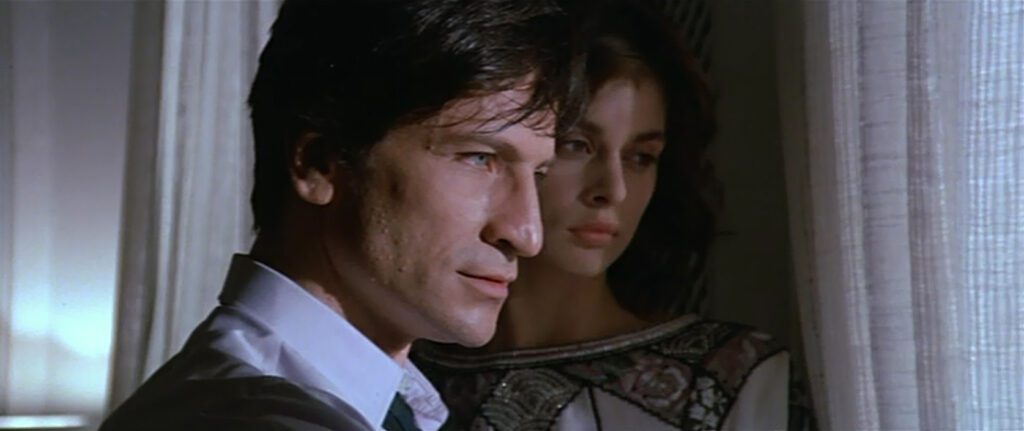
Gérard’s illicit attraction to Loretta, the woman who so clearly reminds him of his sister, is established in two extraordinarily cinematic scenes. The first is her initial appearance. A roll of thunder underscores Newton’s second mention of his sister, and a moment later she arrives to pick up her drunken brother. The headlights of her Ferrari bathe the dark barroom in warm colors; the revving engine heralds her arrival; her eyes appear above the etched glass; the door handle turns slowly; Loretta’s musical theme surges as the doorway frames her like a painting; and a fan tousles her wavy hair. It’s hard to think of a more dramatic entrance in any movie. It’s a consummate picture of glamor.
The second half of Loretta’s introductory portrait comes eighteen minutes later when she picks Gérard up at his house. Her Ferrari stops in front of a billboard for Stromboli Beer, and the tagline “Try Another World” translates what Gérard must read in her eyes as she leans back seductively in the driver’s seat. She looks like a model emerging from the advertisement behind her. As she rises slowly, a low-angle shot frames her like a goddess. Again she’s glamor personified.
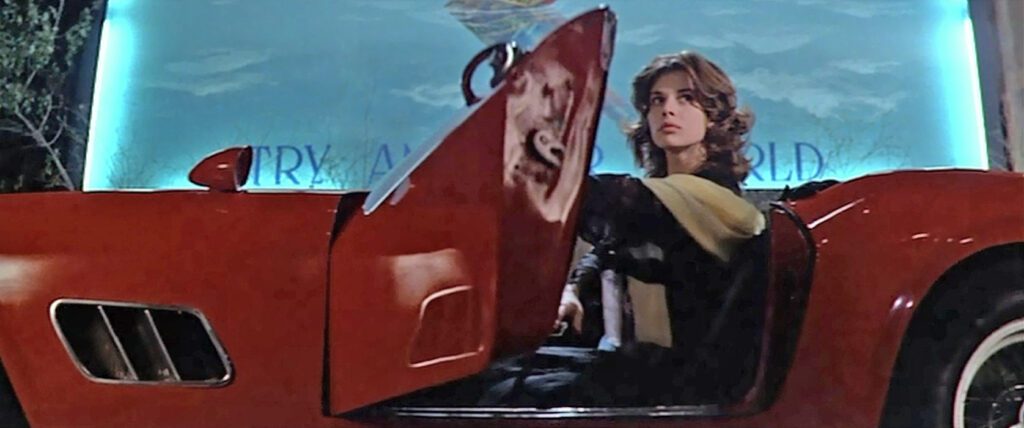
Here exactly is the movie’s point. It means to link two words that are not normally joined together: “glamor” and “incest”. The movie connects these words not in fiction or in theory, but in real life, demonstrating that the desire to possess a glamorous object is rooted in incest. Here it’s necessary to understand that glamor is not the same thing as beauty or sexiness or attractiveness. Gérard’s girlfriend Bella has all those qualities, but he wants Loretta because unlike Bella she also has glamor. Glamor is a surplus quality that idealizes its object, elevating it above ordinary life. It transforms a woman, in her worshipper’s eyes, into a princess or a goddess or any other impossible ideal. When The Moon in the Gutter equates glamor with incest, it reminds us that glamor is psychologically regressive, taking the beholder back to an infantile state when he formed an unrealistically ideal image of someone, usually a close family member.
The Stromboli billboard defines glamor the same way. “Try another world” is an invitation to reject the everyday world for something unattainable. The slogan is memorable enough as the backdrop to this extraordinary scene, but it also lies behind the closing credits. The film does not want to let us escape reckoning with the deceptive allure of those three words.
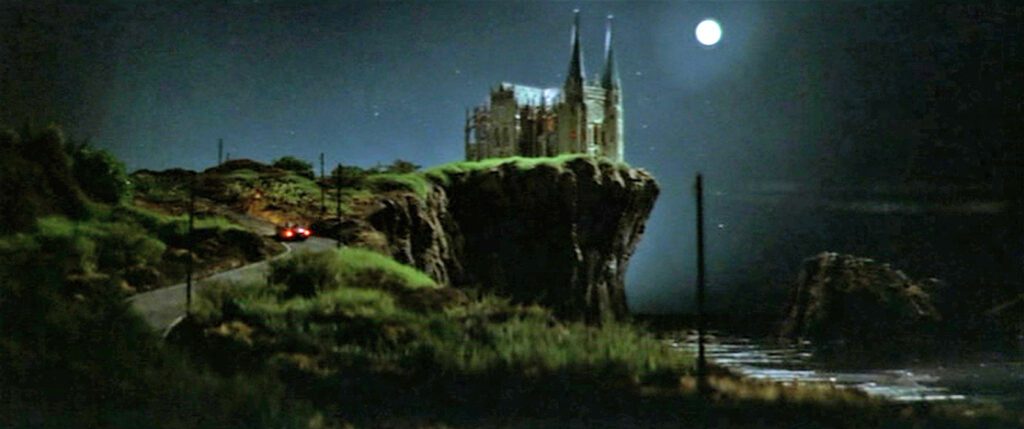
The implicit contrast between a moon and a gutter runs through the entire film, always pointing to the gap between what’s glamorous and what’s not. The Channing mansion could hardly be more different from Gérard’s “crummiest house around”. In Loretta’s presence Gérard’s whole world turns into a fantasy, even the port of Marseille. Her Ferrari glides along the light-speckled dock at night as if floating through a man-made galaxy, while flocks of seagulls skim over the water. The wedding church sits dramatically on a seaside cliff like an illustrated fairy tale, as if Gérard has slipped back into childhood, unable to distinguish between dream and reality. After the wedding he dresses up, slicks back his hair like some kind of social climber, and plays a hero when Bella sends thugs after him. Loretta is seeking her own version of glamor in the gutter, where she believes men are stronger and more heroic. When she photographs Gérard at work, even after he hits her, she looks at him with a perverse desire.
As Alfred Hitchcock’s movies tell us in so many ways, a man who regresses into pre-adolescent sexuality, including a man seduced by glamor like Gérard, is dangerous to himself and others, especially to the women who cross his path. There’s nothing innocent about a return to childhood. Rather than bringing out the playfulness and sweetness of a young boy, it tends to bring out selfishness, impetuousness, and entitlement.
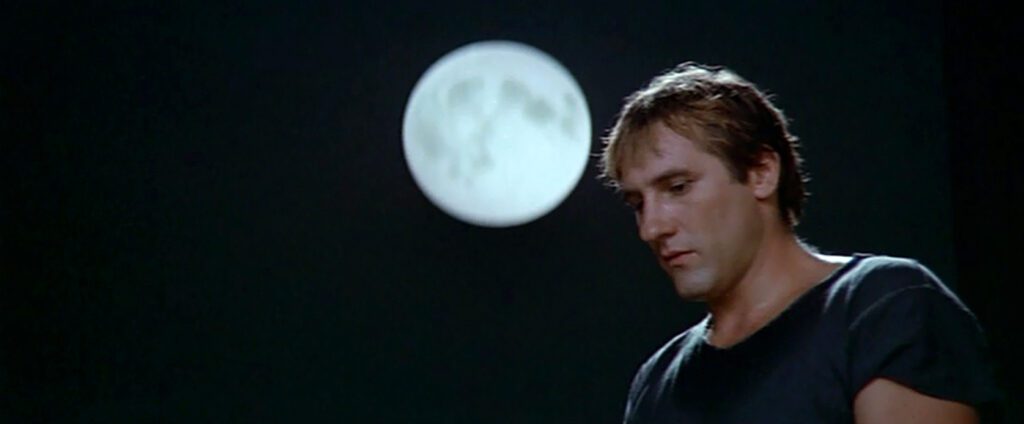
The opening scene pans to reveal Catherine’s body lying in the street, ending incongruously with a close-up of her Pluto wristwatch, and Gérard will wear this watch through much of the movie. The watch reads 10:15, so that Pluto’s minute hand points straight out as if accusing someone. The cartoon dog shares its name, appropriately enough, with the Roman god of the underworld, but Disney’s Pluto comes from Hollywood, which has seduced the modern world with its cult of glamor, teaching men to desire it and women to try to attain it.
The Moon in the Gutter is far from a Hollywood movie, and its story undermines the dramatic effect of its most glamorous and most exciting scenes. Its failure at the box office probably stems as much as anything from its refusal to indulge audiences with the mystery of Catherine’s rapist. The man is never caught, and he’s only perfunctorily identified when a pair of red shoes stepping off a bus tells us that he’s a dock worker. More important is Gérard’s psychological guilt. He’s not the rapist, but his sexual interest in his sister leads him to betray Bella, and it opens the question of what circumstances led to his sister’s suicide. Was she thinking of how her brother would react to her rape?
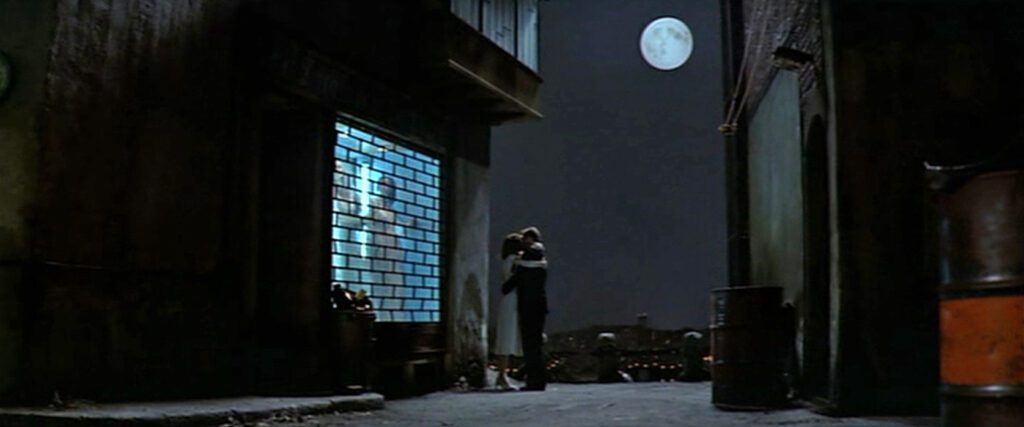
The movie forgoes audience satisfaction to define the psychological reality and effects of glamor, and to trace the road to maturity of a man who, like so many others, has learned to desire glamor in women. At the end, after nearly killing his brother on a false suspicion, he stands in the spot where Catherine had died, wearing the same watch and holding the same razor, vowing once again to find her rapist. Suddenly Loretta drives up as if he had conjured her, looking more like Catherine than ever. Now it’s clear that his wish to be his sister’s hero is inseparable from his wish to be Loretta’s lover. Confronted with the similarity of his two wishes, he finally understands that his attraction to Loretta is tainted and could never be called love. At the end he returns to Bella, who may not be an ideal of purity or glamor, but at least she belongs to the real world.
CONNECTIONS:
Mildred Pierce – Link between incest and glamor; implication of Hollywood’s guilt
Vertigo – Insights into the psychology and social consequences of adult incest
Devi – Critique of glamor as a desire rooted in incest
Mulholland Drive – Hollywood singled out as a force of deception, seducing people with glamor
Dry Season – Protagonist’s wish for revenge disguises a lingering incestuous drive